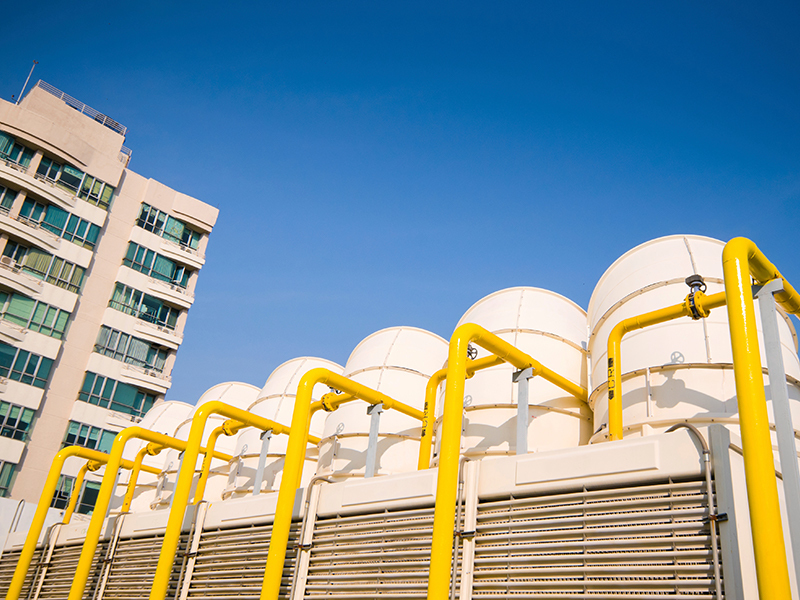Each year we get many of these questions from people, all stemming back to the central question of what is cooling tower lay-up and why do we do it? If any of these sound familiar to you then you may want to read on.
- “We wait to punch tubes until spring.”
- “I just drain the tower piping to the roof line.”
- “We leave the tower filled ‘just in case.'”
- “I don’t have time – just drain the thing.”
- “It was fine last year, so let’s skip lay-up this year.”
- “We have to pick rush chips every year – it’s not bad.”
- “Hey, what are those rust nodules?”
- “We use the wire brush every year.”
Skipping it for a few years, leaving the chiller full all winter, or waiting until spring to clean your system is a recipe for disaster and you may find out just how important proper and timely lay-up can be. Typically, the biggest risk of damage to your equipment occurs when systems are idle. Systems that are drained, cleaned and laid up show less corrosion, less iron-throw in the spring and cleaner equipment than systems that wait until spring or are not laid up at all. Many operators believe their system can hold up to anything that mother nature can throw at them, however, this is often just not the case; and it's not even the cooling tower itself that is the most susceptible to damage – it's the chillers they share their water with. Chillers are expensive pieces of machinery that contain the most important heat transfer surfaces inside of them. Whatever “lives” inside the towers eventually makes its way to the chillers and can clog or form build-ups in the chillers themselves; and we all know a system that runs inefficiently like this costs more in fuel and energy than one that runs free of clogs and deposits.
How you prepare for and conduct a system lay-up depends on the specific equipment being idled, the size of the plant, and the likelihood that the system might be needed to come back to full operation without much warning. Now is the time to protect your system with the right lay-up program. The following recommendations try to take this all into account. Follow the tips and guidelines below and your chiller will thank you with year after year of reliable service and clean operation:
SMALL VOLUME RECIRCULATING SYSTEMS AND CHILLERS:
If the entire system is to be shut down and drained, you should clean and protect the system before hand. This will significantly reduce the amount of chip scale that comes loose next spring during start-up, and will greatly extend equipment life.
Note; Before laying up the cooling system, valve off the water flow to the tower water conductivity controller. Pull corrosion coupons from the rack, if applicable.
- One to two days before shutdown, bleed the tower to the normal operating conductivity. This will help remove excess solids. If feeding acid, maintain normal pH levels.
- Drain the cooling tower basin to the minimum level required for operation. This will reduce the amount of water to be treated.
- Two hours before shut down, add non-oxidizing biocide at normal doses. This will kill and sterilize the system before lay-up.
- Add the lay-up treatment at the following dosages:
Recirculating Tower System Lay-Up: Add Tower Toads at a rate of TWO bags (4 lbs each) of Tower Toads per 1,000 gallons of cooling water volume in system.
- Circulate the system water for 3-6 hours. Drain the system when circulation is complete.
- Physically clean out tower basins of silt and other debris. This is really important as it will help keep your system clean once start-up occurs.
- Close up the system as much as possible to prevent air circulation during lay-up period. This will help minimize rust and corrosion pitting in your system due to air exposure.
- In the spring, re-passivate the metal with 1,600 ppm of TowerClean 819 or 85 ppm of ProCorr 1150. Add during start-up, circulate for 24 hours and allow to bleed out normally during first days of operation.
LARGE VOLUME RECIRCULATING SYSTEMS WITH AN ISOLATED CHILLER LOOP
Due to the economics and possible permitting issues that are associated with large systems, it is often not possible to add cleaners and passivating chemistry to the entire loop before shut down. In this case, you should try to treat just the idle loop as described in the previous section, or at least operational steps to minimize damage during the off-season.
The above are just guidelines, actual treatment options vary depending on the specifics of your system. Your U.S. Water rep can help you develop the best treatment option to meet your needs. Contact us for more information.

